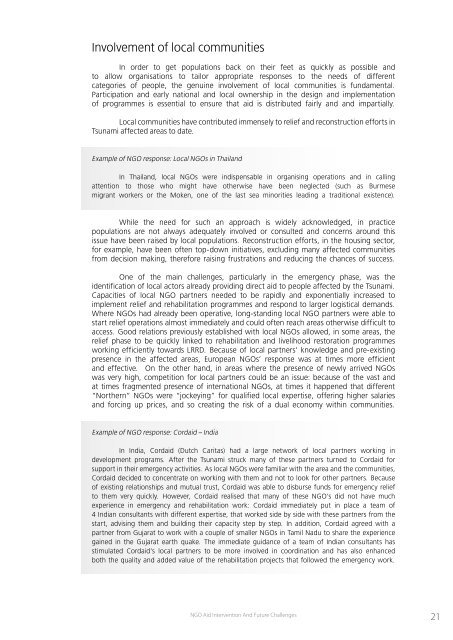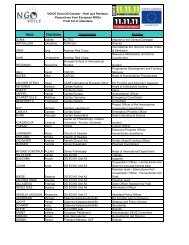Tsunami one year after, NGO aid intervention and future ... - VOICE
Tsunami one year after, NGO aid intervention and future ... - VOICE
Tsunami one year after, NGO aid intervention and future ... - VOICE
Create successful ePaper yourself
Turn your PDF publications into a flip-book with our unique Google optimized e-Paper software.
Involvement of local communities<br />
In order to get populations back on their feet as quickly as possible <strong>and</strong><br />
to allow organisations to tailor appropriate responses to the needs of different<br />
categories of people, the genuine involvement of local communities is fundamental.<br />
Participation <strong>and</strong> early national <strong>and</strong> local ownership in the design <strong>and</strong> implementation<br />
of programmes is essential to ensure that <strong>aid</strong> is distributed fairly <strong>and</strong> <strong>and</strong> impartially.<br />
Local communities have contributed immensely to relief <strong>and</strong> reconstruction efforts in<br />
<strong>Tsunami</strong> affected areas to date.<br />
Example of <strong>NGO</strong> response: Local <strong>NGO</strong>s in Thail<strong>and</strong><br />
In Thail<strong>and</strong>, local <strong>NGO</strong>s were indispensable in organising operations <strong>and</strong> in calling<br />
attention to those who might have otherwise have been neglected (such as Burmese<br />
migrant workers or the Moken, <strong>one</strong> of the last sea minorities leading a traditional existence).<br />
While the need for such an approach is widely acknowledged, in practice<br />
populations are not always adequately involved or consulted <strong>and</strong> concerns around this<br />
issue have been raised by local populations. Reconstruction efforts, in the housing sector,<br />
for example, have been often top-down initiatives, excluding many affected communities<br />
from decision making, therefore raising frustrations <strong>and</strong> reducing the chances of success.<br />
One of the main challenges, particularly in the emergency phase, was the<br />
identification of local actors already providing direct <strong>aid</strong> to people affected by the <strong>Tsunami</strong>.<br />
Capacities of local <strong>NGO</strong> partners needed to be rapidly <strong>and</strong> exp<strong>one</strong>ntially increased to<br />
implement relief <strong>and</strong> rehabilitation programmes <strong>and</strong> respond to larger logistical dem<strong>and</strong>s.<br />
Where <strong>NGO</strong>s had already been operative, long-st<strong>and</strong>ing local <strong>NGO</strong> partners were able to<br />
start relief operations almost immediately <strong>and</strong> could often reach areas otherwise difficult to<br />
access. Good relations previously established with local <strong>NGO</strong>s allowed, in some areas, the<br />
relief phase to be quickly linked to rehabilitation <strong>and</strong> livelihood restoration programmes<br />
working efficiently towards LRRD. Because of local partners’ knowledge <strong>and</strong> pre-existing<br />
presence in the affected areas, European <strong>NGO</strong>s’ response was at times more efficient<br />
<strong>and</strong> effective. On the other h<strong>and</strong>, in areas where the presence of newly arrived <strong>NGO</strong>s<br />
was very high, competition for local partners could be an issue: because of the vast <strong>and</strong><br />
at times fragmented presence of international <strong>NGO</strong>s, at times it happened that different<br />
“Northern” <strong>NGO</strong>s were “jockeying” for qualified local expertise, offering higher salaries<br />
<strong>and</strong> forcing up prices, <strong>and</strong> so creating the risk of a dual economy within communities.<br />
Example of <strong>NGO</strong> response: Cord<strong>aid</strong> – India<br />
In India, Cord<strong>aid</strong> (Dutch Caritas) had a large network of local partners working in<br />
development programs. After the <strong>Tsunami</strong> struck many of these partners turned to Cord<strong>aid</strong> for<br />
support in their emergency activities. As local <strong>NGO</strong>s were familiar with the area <strong>and</strong> the communities,<br />
Cord<strong>aid</strong> decided to concentrate on working with them <strong>and</strong> not to look for other partners. Because<br />
of existing relationships <strong>and</strong> mutual trust, Cord<strong>aid</strong> was able to disburse funds for emergency relief<br />
to them very quickly. However, Cord<strong>aid</strong> realised that many of these <strong>NGO</strong>’s did not have much<br />
experience in emergency <strong>and</strong> rehabilitation work: Cord<strong>aid</strong> immediately put in place a team of<br />
4 Indian consultants with different expertise, that worked side by side with these partners from the<br />
start, advising them <strong>and</strong> building their capacity step by step. In addition, Cord<strong>aid</strong> agreed with a<br />
partner from Gujarat to work with a couple of smaller <strong>NGO</strong>s in Tamil Nadu to share the experience<br />
gained in the Gujarat earth quake. The immediate guidance of a team of Indian consultants has<br />
stimulated Cord<strong>aid</strong>’s local partners to be more involved in coordination <strong>and</strong> has also enhanced<br />
both the quality <strong>and</strong> added value of the rehabilitation projects that followed the emergency work.<br />
<strong>NGO</strong> Aid Intervention And Future Challenges<br />
21






